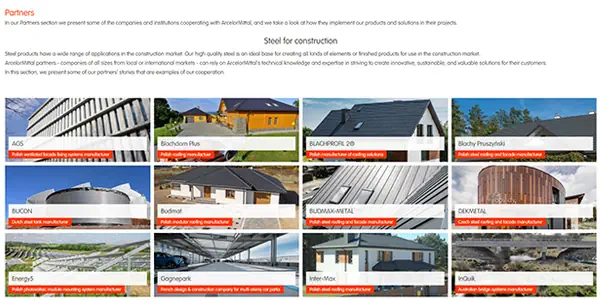Solutions by
Performance
ArcelorMittal strives to make steel production more sustainable and to minimise its environmental impact. As a leader in steel manufacturing, we are committed to making steel production more sustainable at every stage. In addition, 95% of our steel industrial operations now have ISO 14001 certification, an international standard for environmental management systems.
- Granite® is certified as a product not containing hexavalent chromium or heavy metals.
- R2P - Ready to Paint coating on thin gauge, the cold rolled product, is an efficient solution to reduce environmental impact at customer plants; for example, for door production.
- Insulated sandwich panels are contributing to energy efficiency in the most demanding buildings such as cold rooms for the food industry and supermarkets.
“Safe Sustainable Steel” makes up the core values of ArcelorMittal. As such, our innovative products and solutions for construction are continuously contributing to the reduction of environmental impacts on buildings throughout their life.
Environmental impacts
In 2012, the EU-28’s construction sector accounted for:
- 40% of the total final energy consumption
- 40% of CO2 Emission
- 30% of consumption of natural resources
- 30% of waste generation
- 20% of water consumption
Consequently, the EU commission has started to adapt the EU directive regarding environmental assessment - the EIA Directive.
Useful information
MoreAccording to the European Commission, "The newly amended Environmental Impact Assessment (EIA) Directive (2014/52/EU) entered into force on 15 May 2014 to simplify the rules for assessing the potential effects of projects on the environment. Member States have to apply these rules as from 16 May 2017 at the latest." (http://ec.europa.eu/environment/eia/review.htm)
The Holistic Environmental Impact assessment for buildings is defined by European Standard EN 15978 in the scope of CEN TC 350 work programme. It takes into account the full life cycle of the building, including end of life, recycling after demolition, and energy production at the building level.
Related news & technical articles
Discover the game-changer that is Magnelis®
25 April 2024ArcelorMittal's Magnelis® is a game-changer in the world of metallic coatings, offering unparalleled corrosion protection.As the choice of professionals, Magnelis® stands out in the market, not just for its exceptional quality but also for its innovative formulation. It is manufactured using a continuous hot dip galvanising process where it is immersed in a unique molten bath composed of zinc, 3.5% aluminium, and 3% magnesium, giving it its distinctive chemical properties. Thanks to its unique composition, Magnelis® provides an unprecedented level of surface and cut-edge protection, even in the most hostile environments.
Product newsUpdated XCarb® recycled and renewably produced EPDs
18 March 2024Updated Environmental Product Declarations for XCarb® recycled and renewably produced flat products are available now on Constructalia.
Website newsLindab now also uses XCarb® steel for ventilation ducts
30 January 2024As of 2023, Lindab offers products in "Recycled steel 75" as part of its standard range for the Swedish market. This low carbon emissions steel consists of at least 75 per cent recycled steel and is produced in electric arc furnaces powered by renewable electricity. Put together, this means it has up to a 70 per cent lower climate impact than traditionally produced steel made from Basic Oxygen Steelmaking, which includes using a blast furnace.XCarb® recycled and renewably produced steel from ArcelorMittal Europe – Flat Products complies with this target and is verified by an EPD (Environmental product declaration). Lindab has been offering the Swedish market roof and facade products produced from XCarb® steel and has recently extended the offer to also include ventilation ducts.
Product newsSolar trackers made from XCarb® recycled and renewably produced Magnelis® for Portugal
2 January 2024Gonvarri Industries’ photovoltaic solar structures division, Iberdrola, and ArcelorMittal are underlining their commitment to the energy transition with the signing of a new supply agreement for solar trackers for an Iberdrola project in Portugal. ArcelorMittal will provide 211.8 tonnes of its XCarb® recycled and renewably produced Magnelis® - the first photovoltaic project in Iberia to use this material.
Project news




































